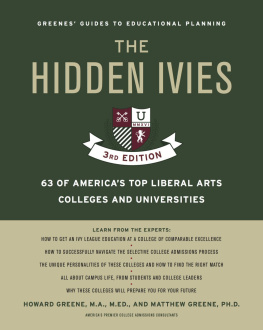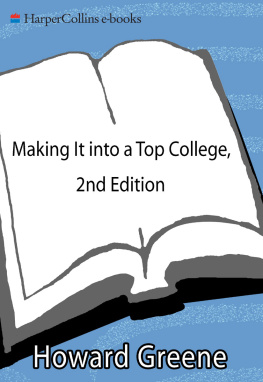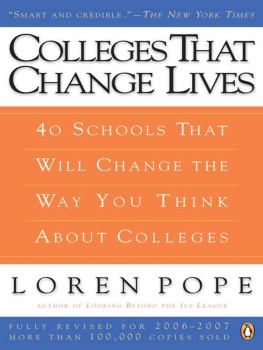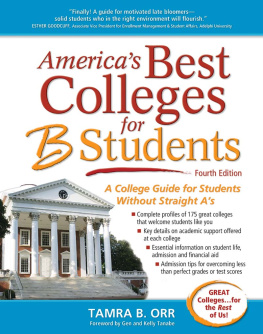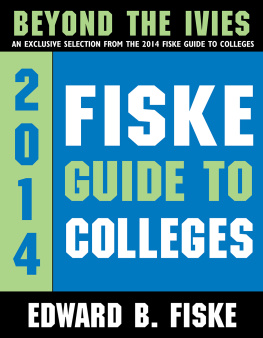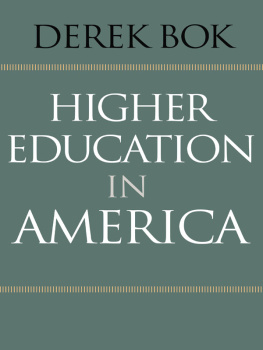
A university should be a place of light, of liberty, and of learning.
Benjamin Disraeli
Training is everything.
The peach was once a bitter almond;
cauliflower is nothing but cabbage
with a college education.
Mark Twain, Puddnhead Wilson
CONTENTS
One of the many benefits of having been grounded in a traditional liberal arts education is the exposure we received to many of the great social and literary thinkers like Samuel Johnson, the eighteenth-century writer.
Johnson said, Knowledge is of two kinds. We know a subject ourselves, or we know where we can find information upon it. As counselors and writers in the educational field since 1968, we possess a fair amount of knowledge about higher education, individual colleges, and the planning process for the transition from high school to college. But there is so much that we cannot know by ourselves. Fortunately, we know where to turn for further information and insight. This book could not have been produced without the support and cooperation of the many individuals who have had much to teach us: the administrative leaders of the colleges represented in this book and the students who are the beneficiaries of the superb education provided by these institutions. In all cases, their enthusiasm for their respective colleges and the honest portrayal of their strengths and special qualities make this book meaningful. To them all we tip our faded mortarboards and thank them for giving so freely of their time and thought.
To the many families we have worked with through the years, we offer our gratitude for your honest and ongoing feedback about the colleges you have visited, attended, and graduated from. Your appraisals, honest and revealing, when added together have helped us shape our understandings of the cultures, strengths, and weaknesses of so many colleges and universities, and have added to our ability not only to write about them, but also to counsel future students accordingly.
Finally, we would like to thank the many editors and larger team at HarperCollins for their support through the years with the Greenes Guides series, and Eric Meyers for his editorial supervision on this third edition of one of our favorite and, we feel, most important books.
As Dartmouth professor Cecilia Gaposchkin has recently pointed out, a liberal arts education is brain training.
A liberal arts degree encompasses all academic disciplines, including the sciences. It is a degree in thinkingin critical thinking It means that liberal education, done right and undertaken with enthusiasm, curiosity and passion, makes you smarter It hones your natural skills of discernment and intellect to productive thought and the creative application of knowledge.
Gaposchkin, Cecilia, Train the Brain ( Dartmouth Alumni Magazine , Nov./Dec. 2015, p. 26)
It seems that the liberal arts and a liberal education are always being questioned, and educators are constantly defending a liberal arts education. There has long been a tension between notions of a more practical or pragmatic , or, as we often say today, an applied education on the one hand, and a more theoretical or general education on the other. Writing about the history of this educational debate, Dan Berrett recently pointed to Ronald Reagans remark in 1967 that taxpayers shouldnt be subsidizing intellectual curiosity ( Chronicle of Higher Education , Jan. 26, 2015). President Obama, himself a liberal arts collegian, found himself apologizing for glib remarks more recently: I promise you folks can make a lot more, potentially, with skilled manufacturing or the trades than they might with an art history degree, Obama said in his speech Jan. 30, which was focused on better aligning job training programs with employer needs ( USA Today , Feb. 19, 2014).
When we set out to write our first edition of The Hidden Ivies some fifteen years ago, we endeavored to explain to readers what a liberal arts education was in the modern era, why we believed it to have continued great value and relevance, and which colleges and universities were representative of truly excellent educational environments. We continued that dialogue in 2009 in our second edition, even as we added institutions to our list and talked about changes in admissions processes and challenges. And here we are, in 2016, expanding our list once again, and finding that the need to help parents, students, and the wider public better understand the meaning and worth of a liberal arts education is as great today as it ever was.
Our mission in writing this book for students and parents is to create greater awareness of a distinctive cluster of colleges and universities of excellence that are available to talented college-bound students. We would be surprised, indeed, to encounter a student or parent throughout the country or outside the United States who has not heard of the exclusive band of elite institutions known as the Ivy League. They have become, in our modern economic universe of marketing, the ultimate brand name for quality education and prestige. It is a challenge not to become intoxicated with the thought of graduating from one of these famous schools. Each year these eight institutions Brown, Columbia, Cornell, Dartmouth, Harvard, Princeton, the University of Pennsylvania, and Yaleare flooded with applications from thousands of fully qualified individuals who, despite the fact that they have done everything one could ask of them as students, will not be invited to enroll in any of these schools. Other universities such as Cal Tech, Duke, Georgetown, MIT, Stanford, Vanderbilt, Northwestern, Chicago, Virginia, and the group historically known as the Little Ivies (including Amherst, Bowdoin, Middlebury, Swarthmore, Wesleyan, and Williams) have scaled the heights of prestige and selectivity and also turn away thousands of our best and brightest young men and women. This is the present situation, and it is one that will be with us for a number of years down the road.
Parents can prepare for their role of supporter and guide to their children as early as junior high school, since numerous surveys have revealed that they are the number-one influence in their childrens choice of college. The more you are armed with information on the breadth of top college choices to aim for and what is required for admission, the better able you will be to serve your son or daughter. Students can profit by readingin the early years of high schoolabout the factors that make for an outstanding college and which ones might match up best for them. If they then follow the essential steps we outline, they will better their odds of being accepted to the colleges of their choice.
Lets go directly to the heart of the matter: There are several dynamics at work that have combined to intensify the competition for admission to the best colleges. The number of high school graduates of exceptional ability and motivation who have set their sights on gaining the very best college education they can have has risen dramatically each year, as has the cost of receiving such an opportunity. Admissions deans at the selective colleges are shaking their heads in astonishment at the academic and other achievements of applicants to their schools. Never before have they seen so many young men and women who have attained such outstanding records in their high schools; performed at such high levels on the SAT and ACT; and garnered so many awards for their artistic, athletic, and intellectual capabilities. They worry, just as parents do, about the constant rise in tuition, fees, and room-and-board expenses. It has become an ongoing contest of increasing financial aid in order to stay ahead of the annual increases in the cost of a selective college education, which, at the top end, is now more than $60,000 per year.

